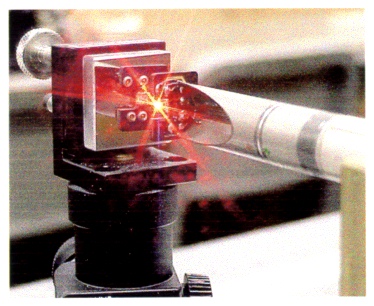Welcome to the Phys 431 Optics Lab. We hope it will be an enjoyable semester
and that we will learn a thing or two. The lab meets at 6pm in Rm 1250 BPS;
Sec. 1 is Monday night, Sec. 2 is Wednesday night, Sec. 3 is Tuesday night.
Below we summarize the content and requirements of the lab.
Requirements
You are required to attend one 2.8 hour lab per week. We require you to use a
lab notebook to assist you in organizing your experimental notes and for
recording raw data. This notebook will not be turned in with your write-ups,
but may be checked for a variety of reasons. Please also bring a 3.5” floppy
to allow you to bring home digital images. There will be no opportunities to
make up missed labs.
Partners
The experiments will be performed in groups of two. (Groups of three should
only occur if an odd number of students attend.) Of course, you should
divide the labor with your partner. For example, only one person need record
the data in their lab book. Although each group must perform the experiment
independently, you are encouraged to observe and discuss experimental points
with the other groups.
Write-ups
Click here for write-up example.
Each partner is required to write a formal report for each experiment performed,
due at the beginning of the following lab. We will have 11 experiments in all.
Each group must perform their own analysis, and the write-ups must be written
independently. Hand written reports will not be accepted. The write-ups should
be prepared using a word processor, such as MS Word, with imported graphics and
images when applicable. The format is based on the style of a Physical Review
article. Each report is worth a total of 10 points. The following sections must
be included (point values shown in brackets).
Title [0]
Title of experiment. Please include your name and the name of your partner at the top of the title page.
Abstract [1]
This briefly states the major result of the experiment. For example:
“A Michaelson interferometer has been used to determine the difference in
wavelength of the sodium D lines. A value of 5.9 ? 0.2 Å was found, which
agrees with the accepted value.”
Introduction [2]
This summarized the main ideas of the experiment and the conclusions of
appropriate theory. A sketch of the experiment should be included.
Analysis & Discussion [5]
Quantitatively compare your data with expectations. Error estimates must always
be given. Do not recopy all the raw data for your report. Give examples and/or
the range of the numerical values where appropriate. Present data by graphs as
much as possible. Do the measurements ? error estimation agree with theory? If not,
can you suggest possible sources of the discrepancy?
Conclusion [2]
A brief statement summarizing your results is required. Did you find what you
expected? What improvements would you make if you were to repeat the measurements?
Labs
Here is a tentative list of the labs. Click below to see the complete procedures. You are strongly
encouraged to read them in advance of each lab.
Grades
Your score will consist of the highest 10 of the 11 write-up scores.
Hence the maximum point total is 10 x 10 = 100. At the end of the semester
your point total will be scaled to count 40% toward your final grade.
Stuart Tessmer, last modified 2003.09.04
